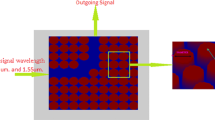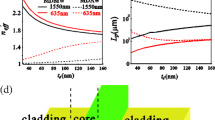Abstract
Transmission characteristics of the 2D metallic photonic crystals in air medium are investigated for THz waveguiding. Finite Element Method (FEM) simulations are used for both design and optimization of the structure in order to increase the transmission bandwidth. Bend waveguides are compared and the effect of rods on the corner of bending corner.
Access provided by Autonomous University of Puebla. Download conference paper PDF
Similar content being viewed by others
Keywords
These keywords were added by machine and not by the authors. This process is experimental and the keywords may be updated as the learning algorithm improves.
4.1 Introduction
Terahertz (THz) waves refer to electromagnetic (EM) radiation in a frequency band between 0.3 and 10 THz, corresponding to wavelengths in the sub-millimeter range. THz science and technology have been developing very rapidly for their potential applications in variety of areas, such as imaging, security, spectroscopy and communication. With the rise of THz frequency based technology and new developments in generating THz radiation, guiding THz waves in an efficient way with low-loss, high performance become of a key relevance. Starting from early studies on THz, new solutions as well as the old ones from microwave or optical frequencies have been proposed for guiding. Among the new solution we can mention metal wires [1], sapphire fiber [2], plastic ribbon waveguide [3], parallel-plate waveguide [4], and photonic crystals [5, 6]. Each of them presents their own individual challenges and advantages.
The main concern in this study is to design a waveguide to guide and manipulate a THz powerful radiation in an efficient way in order to increase the performance of the actual THz devices. For this aim we propose metallic photonic band-gap (PBG) crystal waveguides as an efficient solution. Photonic crystals are periodically distributed materials allowing the control of electromagnetic waves propagation within the crystals. Under condition of refractive index difference between medium and photonic crystal material, the propagation of an EM wave is forbidden within a frequency range called the photonic band gap. These photonic crystal structures can be used to confine or to propagate EM waves within defects introduced in their structure; otherwise EM waves would propagate inside the crystal structure. For interconnection to other devices, waveguides are required to have flexibility of bending. However, bends introduce losses arising from total internal reflection. To overcome this problem, photonic crystals have been studied with the advantages of low losses and low dispersion properties of photonic crystals and almost perfect transmission has been obtained around sharp bends [7]. Nevertheless, metallic band-gap crystals have demonstrated important advantages over the dielectric photonic crystals, such as wider band-gaps and smaller sizes [8].
Metallic photonic crystals have been studied theoretically and experimentally mostly in microwave and optical frequencies [9–12]. Photonic crystal waveguide and waveguide bends are presented here in which a line defect is introduced in photonic crystal structure by removing one row of rods in the middle of square lattice structure. Simulation has been carried out using one of the commercially available tools based on FEM in 2D. Maxwells equations are solved applying non-reflecting boundary conditions in order to simulate the wave propagation in a waveguide design. Due to the 2D simulation, only E-polarization in which the electric field is parallel to the rod axis is considered. The electromagnetic wave confinement is provided using the contrast between metal and vacuum permittivities and some other parameters related to the pattern of the photonic crystal.
4.2 Results
The 2D metallic photonic crystal is used for designing waveguide and bends in square array of copper rods. The dielectric function of copper is calculated by using the frequency-dependent Drude model [13]. Waveguide design parameters: a, the lattice constant is set at 50 μm and the radius to lattice constant ratio, r/a, is fixed at 0.3 in our waveguide designs. Power transmission and reflection characteristics of THz metallic photonic crystal waveguide are shown in Fig. 4.1. The inset of the figure shows the geometry of the waveguide. The circles show the metallic cylindrical rods in photonic crystal waveguide. It can be seen in Fig. 4.1, 3 dB bandwidth is obtained at frequencies between 2.174–3.433 and 3.654–4.737 THz for square array waveguide. The reason of dip observed in transmission spectrum is due to the band-gap characteristic of metallic photonic crystal for the parameters set for waveguide design [14]. In Fig. 4.2(a), three types of bend structure are studied. First one is a 90 ∘ sharp bend (Bend I) and the others are obtained by moving one rod (Bend II) and three rods (Bend III) from one corner to the opposite one. The gray circles show the metallic rods with a radius r = 0. 3a and the black circles show the critical rods with a radius, r c varying between 0.2a and 0.4a. In Fig. 4.2(b), similar trend in the transmission operation can be seen from the first two bend structures characterized by high losses at the higher-frequency part of the frequency range. This is mainly due to the back reflections from rods on the corner of bends. Therefore the transmission can be improved by modifying the bending corner. We investigate the effect of critical rods on the bending corner and consequently on the transmission [15]. As listed in Table 4.1, the transmission bandwidth is directly affected by the critical rods radius. The largest 3 dB bandwidth (without fluctuations) is obtained with bend II when r c is 0.4a. When radius of all rods are set at 0.4a with bend II geometry, 0.613 THz bandwidth is obtained. This demonstrates the importance of the critical rods in the design of the 90 ∘ bends.
4.3 Conclusion
We simulated 2D metallic photonic crystal waveguide and bend structure based on copper in square lattice array at THz frequency range. We investigated the effect of rods on the bending corner by varying their radius and obtained an optimum transmission for a large frequency range. The bend waveguides can be utilized as filters since there is a sharp drop and the transmission is dramatically reduced after this point. Further modifications can also be achieved by reducing the losses caused by modal mismatch.
References
Wang D.K., Mittleman D.M.: Metal Wires for Terahertz Wave Guiding. Nature 432, 376–379 (2004)
Jamison S.P., Mcgowan R.W., Grischkowsky D.: Single-Mode Waveguide Propagation and Reshaping of Sub-Ps Terahertz Pulses in Sapphire Fibers. App. Phys. Lett. 76, 1987–1989 (2000)
Mendis R., Grischkowsky D.: Plastic Ribbon THz Waveguides. J. App. Phys. 88, 7–9 (2000)
Bingham A., Zhao Y., Grischkowsky D.: THz Parallel Plate Waveguides. App. Phys. Lett. 87, 051105 (2005)
Lin C., Chen C., Schneider G.J., Yao P., Shi S., Prather D.W.: Wavelength Scale Terahertz Two-Dimensional Photonic Crystal Waveguides. Opt Exp. 12, 5723–5728 (2004)
Chi C., Wang H., Pai S., Lai W., Horng S., Huang R.S.: Fabrication and Characterization of Terahertz Photonic Crystals. Proceedings of SPIE 46,19–30 (2002)
Mekis A., Chen J.C., Kurland I., Fan S., Villeneuve P.R., Joannopoulos J.D.: High Transmission Through Sharp Bends in Photonic Crystal Waveguides. Phys. Rev. Lett. 77, 3787–3790 (1996)
Kuzmiak V., Maradudin A., Pincemin F.: Photonic Band Structures of Two-Dimensional Systems Containing Metallic Components. Phys. Rev. B 5016835–16844 (1994)
Sigalas M.M., Chan C.T., Ho K.M., Soukoulis C.M.: Metallic Photonic Band-Gap Materials. Phys. Rev. B 52, 11744–11751(1995)
El-Kady I., Sigalas M.M., Biswas R., Ho K.M., Soukoulis C.M.: Metallic Photonic Crystals at Optical Wavelengths. Phys. Rev. B 62, 15299–15302 (2000)
Gadot F., de Lustrac A., Lourtioz J.M.: High Transmission Defect Modes in Two-Dimensional Metallic Photonic Crystals. J. Appl. Phys. 85, 8499–8501 (1999)
Bayindir M., Cubukcu E., Bulu I., Tut T., Ozbay E., Soukoulis C.M.: Photonic Band Gaps, Defect Characteristics, and Waveguiding in Two-Dimensional Disordered Dielectric and Metallic Photonic Crystals. Phys. Rev. B 64, 195113 (2001)
Ordal M.A., Long L.L., Bell R.J., Bell S.E., Bell R.R., Alexander R.W., Ward C.A.: Optical Properties of The Metals Al, Co, Cu, Au, Fe, Pb, Ni, Pd. App. Opt. 22, 1099–1120 (1983)
Smirnova E.I., Chen C., Shapiro M.A., Sirigiri J.R., Temkin R.J.: Simulation of Photonic Band Gaps in Metal Rod Lattices For Microwave Applications. J. App. Phys. 91, 960–968 (2002)
Smajic J., Hafner C., and Erni D.: Design and Optimization of An Achromatic Photonic Crystal Bend. Opt. Exp. 11, 1378–1384 (2003)
Acknowledgements
This work was supported by Enterprise Ireland (Project No. PC/2008/0164).
Author information
Authors and Affiliations
Corresponding author
Editor information
Editors and Affiliations
Rights and permissions
Copyright information
© 2011 Springer Science+Business Media B.V.
About this paper
Cite this paper
Degirmenci, E., Surre, F., Landais, P. (2011). THz Waveguide and Bends Based on Metallic Photonic Crystals. In: Pereira, M., Shulika, O. (eds) Terahertz and Mid Infrared Radiation. NATO Science for Peace and Security Series B: Physics and Biophysics. Springer, Dordrecht. https://doi.org/10.1007/978-94-007-0769-6_4
Download citation
DOI: https://doi.org/10.1007/978-94-007-0769-6_4
Published:
Publisher Name: Springer, Dordrecht
Print ISBN: 978-94-007-0768-9
Online ISBN: 978-94-007-0769-6
eBook Packages: Physics and AstronomyPhysics and Astronomy (R0)






